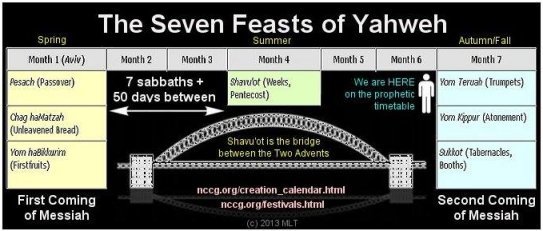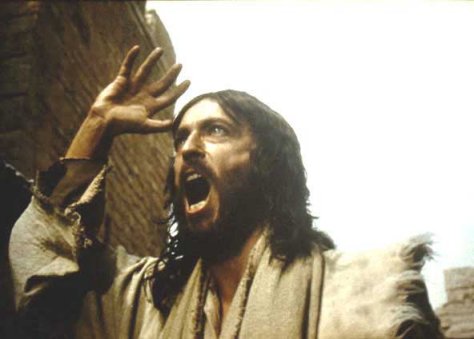Month 7:21, Week 3:7 (Shibi'i/Sukkot), Year:Day 5949:198 AM
2Exodus 5/40
Gregorian Calendar: Monday 1 October 2018
Shemini Atseret 2018
End of an Æon, Start of a New One

Continued from Part 7 (Sukkot 2018)
Introduction
Chag sameach Shemini Atseret and welcome to the festival of Shemini Atseret which literally means the 'Last Great Day', and is the eighth day of assembly of the Sukkot (Tabernacles) season. Yahweh commanded:
"On the eighth day hold an assembly and do no regular work. Present an offering made by fire..." (Num.29:35-36a, NIV).
Why are We Here Today?
Why has Yahweh commanded us to 'atzeret', which comes from a root word meaning 'to hold back', 'tarry', or 'hang around' for another day? What exactly are we here for? To understand that, we must know the divine tavnith (pattern) of all the other moedim, appointments or festivals, together.
Understanding the Tavnith of the Festivals
We begin with the seven days of the Pesach (Passover) season and then we proceed, at the end of that, counting seven sabbaths plus seven weeks or 49 days, which reaches a climax on the 50th day - around 100 days in total - with Shavu'ot, the Feast of Weeks, or 'Pentecost'.

The Shavu'ot- Shemini Atseret Reflection
The deliverance of Israel at Pesach (Passover) is followed by the giving of the Torah through Moses at Shavu'ot (Weeks), so there is a parallel between Shemini Atseret (the Last Great Day) and Pesach (Passover). Thus as the Fourth Festival, Shavu'ot (Weeks), has been traditionally understood to be the conclusion of the seven day-long Pesach (Passover) season, so the Eighth Festival, Shemini Atseret, has likewise been understood to be the conclusion of the seven day-long Sukkot (Tabernacles) season. And as the Written Torah was the fruit of the Pesach (Passover) season, so the Living Torah is the fruit of the Sukkot (Weeks) season:
"In the beginning was the Davar/Miltha/Logos (Word, Manifestation, Instance, Substance), and the Davar/Miltha/Logos (Word, Manifestation, Instance, Substance) was with Elohim (God), and theDavar/Miltha/Logos (Word, Manifestation, Instance, Substance) was Elohim (God). He was with Elohim (God) in the beginning" (John 1:1-2, NIV).
The Davar and Torah
The Davar/Miltha/Logos (in Hebrew, Aramaic and Greek, respectively) is simultaneously emet (truth) or reality on an impersonal level (like the written Torah - represented by Shavu'ot) as well as on a Personal level (like the living Torah, which is Yah'shua the Messiah/Jesus Christ - represented by Shemini Atseret). Even more interesting, for those of you who like deep things:
"the Aramaic phrase B'resheet aytohi hwa miltha breaks a basic rule of Aramaic grammar by combining a feminine noun (miltha) with two masculine verbs for 'to be' (aytohi, hwa). This is unheard of in Aramaic literature other than right here in this passage and in 1 John" [1].
Male and Female Aspects
Not only does this show that in the Elohimhead (Godhead) there are both male and female aspects and persons but it reveals a male/female distinction between Shavu'ot (Weeks) and Shemini Atseret. What happened at the first Messianic Shavu'ot (Weeks, 'Pentecost') in Jerusalem? The Ruach haQodesh (Holy Spirit) was given in place of the physical presence of the Yah'shua (Jesus) who had ascended to Heaven. What gender is the Ruach haQodesh (Holy Spirit). Female. What happens in the autumnal festivals? Yah'shua (Jesus) returns physically. What gender is Yah'shua (Jesus)? Male. Can you fill in the dots between the two points?
Understanding Delegated Authority
When father is away at work, who is in charge of the home? Mother. She is given executive authority to represent him as though he were present in all matters. She represents her husband as a plenipotentiary, just as Yah'sua (Jesus) was when He was representing His Father. When he returns home that authority automatically reverts to Him. This is exactly the same with Yah'shua (Jesus) and the Ruach (Spirit). She represents Yah'shua (Jesus) while He is physically absent following His resurrection and ascension, while he is in Heaven. When He returns to judge the world and hold the Bridal Feast of the Lamb, executive authority is returned to the Saviour. And there it remains until everything is once again returned to the Father so that He may be "all in all" (1 Cor.15:28, NIV).
A Day Beyond Time
Shemini Atseret is quite literally a 'day beyond time' because it represents the first day of a new aeon or age - the symbolic 'eighth' day. And that aeon begins on the first day of the Millennium.
Shemini Atseret and the Millennium
Now I know there are different interpretations of what Shemini Atseret means both in messianic as well in evangelical circles and we don't have time to examine them today. There are those who believe the Millennium is a desolate world inhabited only by demons (the Seventh Day Adventists), there are those who believe we are already in the Millennium (the Catholics and Pretersists), and there are one or two who believe that the Millennium is only for the martyrs during, and the survivors of, the Great Tribulation [2], to name but three theories. I have my exegetical reasons for believing as I do, and have explained them elsewhere, but I also have the benefit of a vision Yahweh showed me many years ago of my home in the Millennial aeon (age). And as I know I will not live to see the Great Tribulation or Second Coming, again because of what Yahweh has told me, this is a second testimony to me as to what the Millennium is and who will live in it.
He Stood and Shouted!
But now let us get to the core of today's message which I hinted at yesterday and it is based on the text of Yah'shua's (Jesus') sole recorded message delivered at Shemini Atseret. It's particularly important because Yah'shua (Jesus) did something that neither He nor other teachers in Israel usually did. He not only stood up to speak instead of making His delivery sitting down, as was the practice, but he also shouted out His message loudly as the dramatic water libation ceremony was being enacted:
"On the last and greatest day of the Feast, Yah'shua (Jesus) stood and said in a loud voice ('shouted' - NLT), 'If anyone is thirsty, let him come to Me and drink. Whoever believes in Me, as the Scripture has said, streams of living water will flow from within him.' By this He meant the Ruach (Spirit), whom those who believed in Him were later to receive. Up to that time the Ruach (Spirit) had not been given, since Yah'shua (Jesus) had not yet been glorified" (John 7:37-39, NIV).

Atypical Behaviour
This is not usual behaviour on the Master's part, nor is the message typical - He is making use of a passage from Isaiah which read:
"Yahweh will guide you always;
He will satisfy your needs in a sun-scorched land
and will strengthen your frame.
You will be like a well-watered garden,
like a spring whose waters never fail" (Isa.58:11, NIV).
Living Water
This was not the first time Yah'shua (Jesus) used the illustration "living water" - does anybody remember an earlier usage of the imagery? The Samaritan woman!
"If you knew the gift of Elohim (God) and who it is that asks you for a drink, you would have asked Him and He would have given you living water" (John 4:10, NIV).
The Gift of Aeonian Life
Notice that this "living water" is a "gift", it doesn't cost anything. In the Greek translation, the word for "gift" is only used here in this Gospel and specifically emphasises Yahweh's grace - His 'undeserved loving kindness', His 'unmerited favour', which may be received through Messiah. He gave this gift of aeonian chayim (life) freely. And in the passage that we are looking at, which He shouted standing up at Shemini Atseret, He is referring to the Ruach haQodesh (Holy Spirit). We obtain this aeonian chayim ('eternal life') exclusively from, and through, the Ruach haQodesh (Holy Spirit), as John explained in the Saviour's Shemini Atseret statement.
The Moed Whose Characteristic is Aeonian Life
So important is this emet (truth), and so central is this emet (truth) to His message, that He shouted it standing up on the Last Great Day of the Sukkot season because Shemini Atseret is the first day of that Aeon or Age which is characterised by Aeonian chayim ('eternal life').
An Aeon for All the Bride
This is another reason why we know that the Millennium is the first aeon (age) which is governed by aeonian chayim ('eternal life') and isn't just a special treat for the Tribulation martyrs and survivors while all the other good believers have to wait another thousand years for their resurrection. It's for all the Bride, from all generations, all those of the first resurrection, who receive it ahead of those who do not possess this chayim (life) in its fullness because they have not made space in their hearts through repentance to receive it.
A Foretaste for Believers Now
We can enjoy a taste of that gift here and now in this Messianic Aeon (Age), even if it isn't a planet-wide reality yet, nor can it be, until Satan and his hoardes are imprisoned in the pit (Rev.9:1-12). The gift was first received at the first Messianic Shavu'ot (Weeks) about nine months after Yah'shua (Jesus) stood up and proclaimed this wonderful message in a loud voice.
The Importance of Patient Waiting
Why the long delay between the autumn (fall) and spring each year? And why didn't He send the gift of the Ruach haQodesh (Holy Spirit) sooner? They had to wait some weeks - between the time of the Ascension and the first Messianic Shavu'ot (Weeks) when the Ruach (Spirit) came. Why not give them the Ruach (Spirit) as soon as He ascended? (Ac.1:9-12) To teach us the importance of patient waiting, which is what we are supposed to use the long winter for, between the festival seasons too. For one thing, prophecy had to be fulfilled to fulfil the revelatory symbolism. That is why we have to learn patience, that is why we must learn how to wait, as Abraham did for the promised seed. Not everything is instantly handed on a platter, not even the free gift of aeonian chayim ('eternal life').
The Bride is a Joint Witness
In another Johannine writing, we hear echoes of the same theme, but this time the Bride joins in the witness of the Ruach (Spirit), specifically because the Bride has the Ruach (Spirit), showing the female submissive nature of both the Ruach (Spirit) and the Bride (true men and women believers), again showing perfect tavnith (pattern):
"The Ruach (Spirit) and the Bride say, 'Come!' And let him who hears say, '"Come!' Whoever is thirsty, let him come; and whoever wishes, let him take the free gift of the mayim chayim (water of life)" (Rev.22:17, NIV).
How the Torah Fits into the Picture
And so John has given us a threefold witness. Finally, one last but important link in the chain, and that is where the Torah or Divine Law - the Constitution of the Kingdom of Elohim (God) - fits into the picture, showing the practical side of the Ruach-filled life by means of a similitude:
"Blessed is the man
who does not walk in the counsel of the wicked
or stand in the way of sinners
or sit in the seat of mockers.
But his delight is in the Torah (Law) of Yahweh,
and on his Torah (Law) he meditates day and night.
He is like a tree planted by streams of water,
which yields its fruit in season
and whose leaf does not wither.
Whatever he does prospers" (Ps.1:1-3, NIV).
Establish a Pattern of Living
Blessed - happy - are those who revere Yahweh and do His will [3] who put their trust in Him [4] and are so blessed by Elohim (God) [5]. When we are called to "walk in" the way of the righteous, this means we are called to order our lives accordingly, by establishing a pattern of living, that is, a lifestyle, a daily habit. In being called to "stand", just as Yah'shua (Jesus) "stood" for His Shemini Atseret proclamation, we are to station ourself - firmly and securely - in this Torah lifestyle which can only be lived to the full, and spontaneously and joyfully, through the anointing of the Ruach haQodesh (Holy Spirit) who provides us with the enabling "streams of water", the mayim chayim or "waters of life" which flow out of the one so spiritually regenerated by emunah (faith) through the grace of Elohim (God). Such a one yields spiritual "fruit in season" that comes through patient waiting as Yah'shua (Jesus) does His gradual but efficient and effectual work within the souls of those He saves.
Patient Endurance
This is the message we are to stand and shout to the world at the appointed moments when they will be received! Such a one who lives thus "prospers" in "whatever he does" just like Joseph of Egypt who, though "distressed" because of his "sufferings", learned "patient endurance" (2 Cor.1:6, NIV), [6] the very same "patient endurance on the part of the qodeshim (saints, set-apart ones) who obey Elohim's (God's) mitzvot (commandments) and remain faithful to Yah'shua (Jesus)" (Rev.14:12, NIV).
Good Things Await the Faithful
And so it is we come to the end of the seasonal moedim (appointments) for this year. Through trusting and obeying His mitzvot (commandments), we can expect to be pleasantly surprised by tiqveh (hope). Good things await us if we will do these things. But if we do not, we have no promise.
Conclusion
So it is time to move on. Who will come? Who will follow? May you all have a blessed and delightsome winter. We shall meet again, Yah willing and health permitting, next spring in the first month of Aviv. And if we are not here because Yahweh has taken us home, then others will be. Join with them. Make your offering by fire - lay all on the altar of sacrifice, for "the sacrifices of Elohim (God) are a broken spirit; a broken and contrite heart" (Ps.51:17, NIV). Let the old self be burned up once and for all so that Messiah can fully live within you and prosper you. Then you will live, and live fully. Grace and peace to you all, in Yah'shua's (Jesus') Name. Amen.
Endnotes
[1] Gabriel Roth, Aramaic English new Testament (Nezari Press, USA: 2012), p.232
[2] See Sukkot 2018 V: Festival for the First Resurrected and especially the Readers' Comments section
[3] Psalm 94:12; 112:1; 119:1-2; Proverbs 29:18 cp. Psalm 41:1; 106:3; Proverbs 13:21; Isaiah 56:2
[4] Psalm 40:4; 84:5,12; 144:15; 146:5; Proverbs 16:20; Isaiah 30:18; Jeremiah 17:7 cp. Psaklm 2:12; 34:8
[5] Psalm 41:1.3; 144:12; Matthew 5:3-12
[6] Also see Revelation 1:9; 13:10
Comments From Readers
[1] "Encouraging, thank you!!!!" (MT, USA, 1 October 2018)


| 

